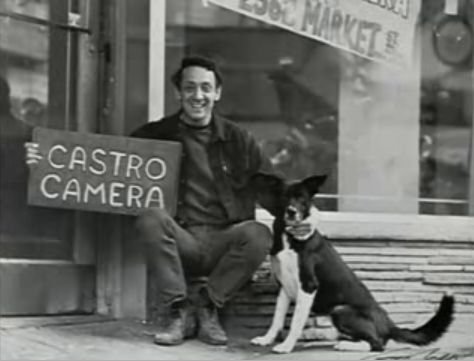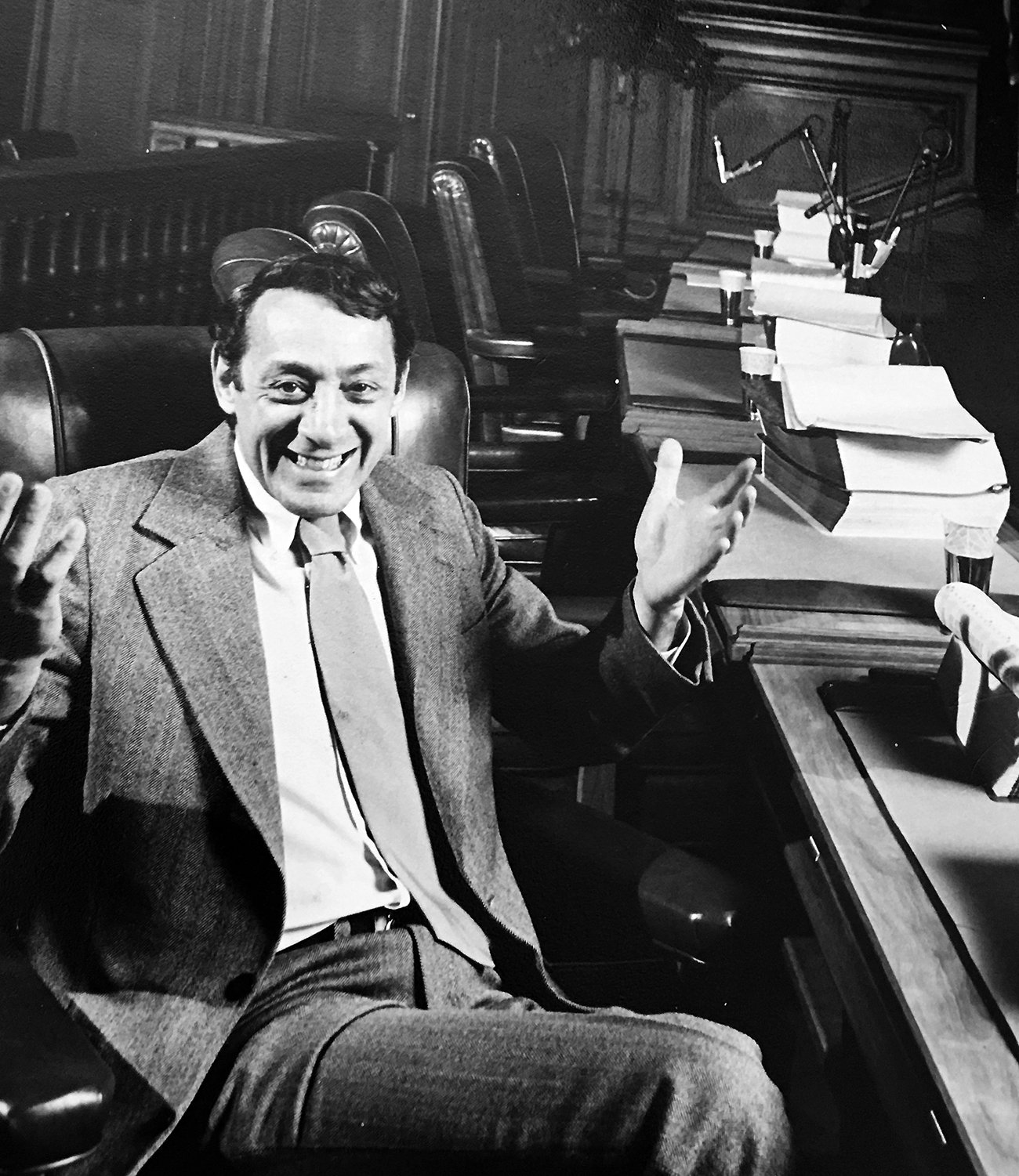Harvey Milk on Fire Island 1950’s
You would be surprized by people who you never thought could be part of Fire Island history. Visionary civil and human rights leader, and one of the first openly gay elected officials in the United States Harvey Milk is one.
Harvey Milk 1930- 1978
Harvey Milk and Joe Campbell, September 1956
Harvey Milk, was a visionary civil and human rights leader who became one of the first openly gay elected officials in the United States when he won a seat on the San Francisco Board of Supervisors in 1977. Harvey was born May 22, 1930, in Woodmere, New York. Harvey and his one sibling, Robert, worked in the family’s department store, “Milks”; his Lithuanian born father, William, served in the U.S. Navy and as did his spirited, independent mother Minerva, also of Lithuanian heritage, who was a “Yeomanette” during World War I. Har‐ vey came from a small middle-class Jewish family that had founded a Jewish synagogue and was well known in the New York “Litvaks” community for their civic engagement. He knew he was gay by the time he attended Bayshore high school, where he was a popular student with wide-ranging interests, from opera to playing football.
Harvey Milk,
served in the Navy during the Korean War but was discharged after being questioned about his sexual orientation.
Milk entered the civilian working world in New York, as a public school teacher on Long Island, as a stock analyst in New York City, and as a production associate for Broadway musicals, including Jesus Christ Superstar and Hair. During the 1960s and early 70s, he became more actively involved in politics and advocacy and he demonstrated against the Vietnam War.
Late 1972, Milk moved to San Francisco, where he opened a camera store on Castro Street, in the heart of the city’s growing gay community. It quickly became a neighborhood center. Milk’s sense of humor and theatricality made him a popular figure. Little more than a year after his arrival in the city, he declared his candidacy for the San Francisco Board of Supervisors. He lost that race, but emerged from the campaign as a force to be reckoned with in local politics.
In 1975, he ran again for the combined San Francisco City/County supervisor seat and narrowly lost. By now, he was established as the leading political spokesman for the Castro’s vibrant gay community. His close friend and ally Mayor George Moscone, appointed him to the city’s Board of Permit Appeals, making Milk the first openly gay city commissioner in the United States. Milk soon filed candidacy papers for the state assembly, but lost his race to represent the Sixteenth Assembly District. Realizing that he would have a greater chance of political suc‐ cess if he relied on voters in the Castro, he then worked with with his campaign manager, Anne Kronenberg and Mayor Moscone for the passage of an amendment that would replace at-large elections for the Board of Supervisors with district elections. In 1977, he easily won his third bid, and was inaugurated as a San Francisco City-County Super‐ visor on January 9, 1978. This was an important and symbolic victory for the LGBT community as well as a per‐ sonal triumph for Milk. His election made national and international headlines.
On November 27, 1978, a disgruntled former city Supervisor assassinated Milk and Mayor George Moscone. Dan White sneaked into City Hall through a basement window, avoiding the metal detectors at the official entrances, went to Moscone’s office, killed him, then walked down the hall to kill Milk. That night, a crowd of thousands spontaneously came together on Castro Street and marched to City Hall in a silent candlelight vigil that has been recognized as one of the most eloquent responses to violence that a community has ever expressed.
On November 27, 1978, a disgruntled former city Supervisor assassinated Milk and Mayor George Moscone. Dan White sneaked into City Hall through a basement window, avoiding the metal detectors at the official entrances, went to Moscone’s office, killed him, then walked down the hall to kill Milk. That night, a crowd of thousands spontaneously came together on Castro Street and marched to City Hall in a silent candlelight vigil that has been recognized as one of the most eloquent responses to violence that a community has ever expressed.
Harvey Milk
believed that government should represent individuals, not just downtown interests, and should in‐ sure equality for all citizens while providing needed services. He spoke for the participation of LGBT people and other minorities in the political process.
The more gay people came out of the closet, he believed, the more their families and friends would support protections for their equal rights. In the years since Milk’s assassination, public opinion has shifted on gay marriage, gays in the military, and other issues, and there have been hundreds of openly LGBT public officials in America, yet the work continues. The Harvey Milk Foundation, established by his nephew, Stuart Milk, and Anne Kronenberg, his campaign manager and aide, is dedicated to realizing his vision of equality and authenticity for everyone, everywhere.
Joe Campbell (November 4, 1936 – 2005)
was an actor most famous for his minor role in the 1965 Andy Warhol film “My Hustler” in a role called the Sugar Plum Fairy and used in Lou Reeds song Walk on the Wild Side . The film was shot on Fire Island and is Warhol’s camp tour de force concerns an idle competition on an empty summer day between tartly monologuing middle-aged queen Ed Weiner, his female Fire Island neighbor, and aging male prostitute, “The Sugar Plum Fairy,” for the attentions of peroxide-blonde “Dial-a-Hustler” hunk Paul America, ogled from the veranda. Bitchy, bitter, and among the flat-out funniest of Warhol productions.
Joe met Harvey in 1956, and the staid businessman didn’t seem enough – attractive enough, rich enough, and certainly not chic enough – to warrant the attentions of the dazzling Sugar Plum Fairy. He would remain in a relationship with Harvey for seven years.
Harvey’s late 60s boyfriend, Billy Sipple, became famous in September 1975, when he thwarted Sara Jane Moore’s attempt to shoot Gerald Ford. Campbell himself died at home in California in 2005, after 29 years of a relationship with Stanley Jensen.
On September 22, 1975 President Gerald Ford was in San Francisco to deliver a luncheon speech to a foreign af‐ fairs group at the St. Francis Hotel. Outside, Oliver Sipple, a former Marine and Vietnam veteran, was in the crowd waiting for Ford to exit the building. Standing next to Sipple was Sara Jane Moore. Earlier that day, Moore called federal authorities threatening to “test” Ford’s security. . That day as President Ford left the hotel, Sara Jane Moore pulled a .38 Smith & Wesson revolver from her purse, pointed it at the President, and fired a shot. As she fired, Sipple reached out and grabbed her arm. Moore’s shot missed Ford by just five feet. Sipple was never contacted directly by President Ford the man whose life he saved, and Harvey Milk was convinced that it was because Sipple was gay. (The White House mailed a letter of appreciation four days after the assassination attempt.) But Sipple told friends that he wasn’t interested in the attention he “just wanted a little peace and quiet.” Sipple, who was on psychological disability because of wounds suffered in Vietnam, declined physically in the years following the assassination attempt. He drank heavily, and told all who would listen that he wished he never grabbed Moore’s gun. Oliver Sipple died, alone, of pneumonia in his Tenderloin District apartment in 1989. . President Ford and his wife sent a letter of sympathy to his family and friends.
This Rink photo from 1977, just a year before Milk's assassination, shows Milk with his lover, Scott Smith (1948–1995)
Joe Campbell eventually left New York and settled into a quiet life in Marin County, California. In 1993 he donated some of the letters he received from Harvey Milk to the Gay and Lesbian Historical Society in San Francisco. Some of those letters are now available for viewing at the San Francisco Public Library website.
Among his many posthumous honors, Harvey Milk was awarded the Presidential Medal of Freedom by President Obama in 2009. Milk became the first openly gay elected official to be issued a stamp by the United States Postal Service, and the Navy has named a Military Sealift Command fleet oiler, currently being built USNS Harvey Milk. A new children’s book, Pride: The Story of Harvey Milk and the Rainbow Flag introduces kids to LGBT advocates Harvey Milk and Gilbert Baker, and teach the history behind the beloved pride symbol. Written by Florida-based author Rob Sanders and illustrated by New York-based artist Steven Salerno, the book was released in April 2018.
2021. The Navy christened the USNS Harvey Milk, a fleet replenishment oiler named after one of the nation's first openly gay elected officials.










